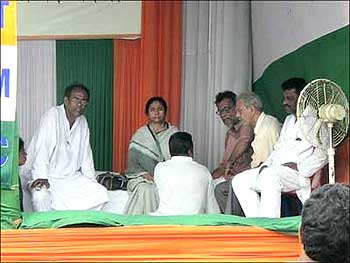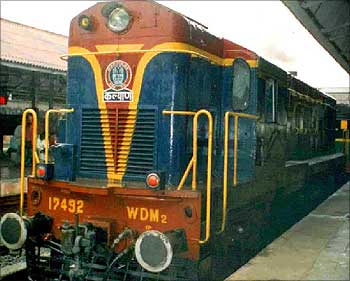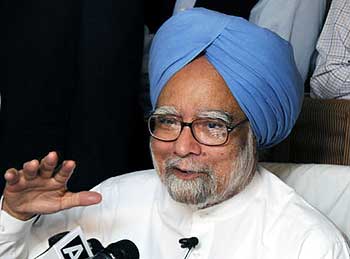
A few weeks back, West Bengal saw Mamata Banerjee in a new avatar.
Addressing a business gathering in Kolkata, India's firebrand railway minister sent out a signal that she was pro-industry and would launch a no-holds-barred effort to nurture industrialisation in West Bengal.
Such a stand is in sharp contrast to the image that Banerjee portrayed as she sat on an indefinite dharna in Singur demanding the Tatas set up the Nano factory on 600 acres of land (of the 1,000 acres allotted to it by the state government) and return the rest 400 acres to the farmers.
"I am not against industrialisation. But I want industry to co-exist with agriculture. I am against industry that kills farming," she had told rediff.com at the dharna manch.
Neither the Tatas nor the West Bengal government succeeded in making her change her mind and ultimately Nano factory had to be shifted out of Bengal to Gujarat.
However, on tasting success in the Lok Sabha elections in May and after assuming charge of the railway ministry, Banerjee made her pro-industry stand clear when she announced the formation of a 'land bank'.
So what is this land bank? Will it be effecetive? How far will it be successful in solving the problem of land acquisition that plagues West Bengal? Read on to find out...

A pro-industry image of Mamata?
With a view to utilising surplus land for commercial purposes, Indian Railways recently created a land bank of 1.12 lakh (112,000) acres across the country.
"Our land bank is ready now as we have surplus land of 1,12,000 acres at 103 sites across the country. This will be utilised for commercial purposes," Mamata Banerjee said, while flagging off three new trains in New Delhi on August 30.
Sending across a message that she was not against industry, the minister also said she was for inclusive growth with industry, agriculture and the common people thriving together.
"We are creating a land bank for which 1,12,000 hectres have been earmarked.This land will be utilised for setting up the projects that have been proposed in the Railway Budget," she had told a business gathering, the first of its kind after she assumed office, comprising representatives of chambers of commerce and trade bodies.

Land bank proposed in Railway Budget itself
While presenting the Railway Budget in July, the railway minister had promised to set up a land bank so that industry can use it if need be.
A land map, she had said, would be made available, adding, "I have decided to set up a committee comprising members of the business houses as well for formulating a good business plan. So that we can immediately start work on the Eastern Corridor."
"There will be a monitoring team to keep a strict watch on the progress. We have no time to lose."
The railway minister had also said that no land was acquired from farmers for the land bank.

1.12 lakh acres of vacant land across 16 zones
Banerjee had said the railways have 1.12 lakh acres of vacant land spread across 16 zones which were to be utilised to create the land bank. The land would be used for setting up industrial hubs, commercial development and other purposes connected with working of railways.
She said 510 acres of railway land has been entrusted to government agencies, semi-government agencies and other authorities for public purpose.
About 3,568 acres of railway land has been entrusted to Rail Land Development Authority for commercial development of land which is not required immediately for railway operational needs, she said.
Banerjee had also mentioned that the Railways earned Rs 541.95 crore (Rs 5.41 billion) in 2008-09 from land given to other authority. It earned Rs 476.51 crore (Rs 4.76 billion) in 2007-08, Rs 356 crore or Rs 3.56 billion) (2006-07), Rs 201.45 crore or Rs 2.01 billion (2005-06) and Rs 200.80 crore or Rs 2 billion (2004-05).

Mamata's stand: Land sharks mint money
Banerjee's opposition to government intervention in land acquisition helped her gain enormous political mileage, but it has left industry in West Bengal with Hobson's choice: abandon projects or appoint hundreds of land brokers who can run amok, says a Business Standard report.
A case in point is a recent incident involving Vedic Village, a local spa and resort, where locals turned their ire on one of the land brokers, leading to the death of one and substantial damage to property.
Vedic Realty, which runs Vedic Village Spa Resort, was developing a 1,500-acre information technology township, which would also house Infosys and Wipro, as part of a deal with the state government.
For land acquisition, Vedic Realty had to appoint 'hundreds of brokers', which led to a lot of unpleasantness with the locals.
If industry has to acquire land directly, it has little option but to appoint brokers in a state like Bengal, where the average landholding is less than an acre due to the land reforms or redistribution programme of the state government in the late 1970s.

Impossible to deal with farmers without government intervention?
According to industry head honchos, it is often impossible to deal with the thousands of farmers without government intervention.
If government help is not sought, industrialists are left with no option but to involve land brokers. And that leads to trouble.
At present, West Bengal government has decided not to acquire land for projects where notifications for land acquisition have not been issued, which means industry has to depend on brokers over whom it has little or no control at all.
According to industry sources, brokers often inflate the land prices beyond limit and even demand Rs 25 lakh (Rs 2.5 million) an acre, while the market price stands at Rs 800,000 an acre.

Govt has to intervene, says Nirupam Sen
West Bengal Commerce and Industry Minister Nirupam Sen holds that 'acquisition of land by the government is the most transparent method and protects the poorest of the poor as far as possible. Those who are the most vocal in their opposition against this method are the brokers, and not the farmers, because their business is at stake.'
According to him, in a democracy, a farmer could demand his rights and the government is bound to respond.
The government not only compensates the people fairly, but also rehabilitates and resettles them. Private developers do not, in most cases.

Why the Land Acquisition Bill was put off by UPA
The United Progressive Alliance government at the Centre put off the Land Acquisition Bill after the railway minister wanted her suggestions incorporated.
One of the clauses in the Bill states that the government should not play a role in acquiring land for private projects, one of the main contentions of Banerjee.
The bill also suggests that a 15-member committee be set up by every state govt to oversee the smooth acquisition of land by industry, and such a committee should be chaired by the state's chief secretary.
But the railway minister objected that the bill does not talk about any mechanism that will take necessary action against the committee, in case of irregularities and does not include the Opposition.
Making it clear that she did not want any state role in land acquisition for industry, Banerjee said the clause enjoining the private party to acquire 70 per cent of the land while the government would, if needed, help with the remaining 30 per cent had to be changed.
Banerjee's argument: Is it full proof?
The railway minister had argued that in a state like West Bengal, with fragmented land holdings, problems are bound to crop up in land acquisition bids. And in that event, the proposed law would kick in, empowering the state government to intervene.
Here are Banerjee's suggestions:
Interestingly, in West Bengal at present, some of the land which is being acquired under the Land Acquisition Act 1894 for the Indian Railways, is double-crop and multi-crop.
Therefore, it is not too clear how sound is Banerjee's stand on land acquisition and subsequent development of a land bank.